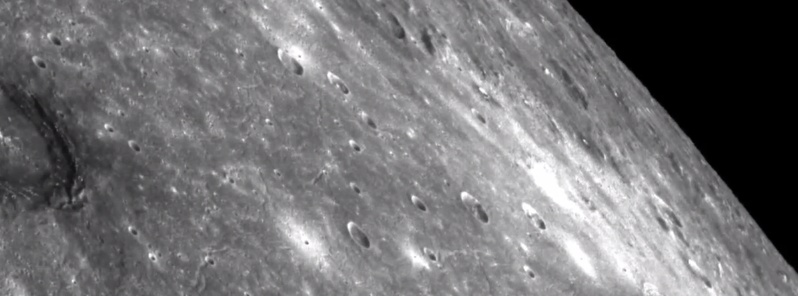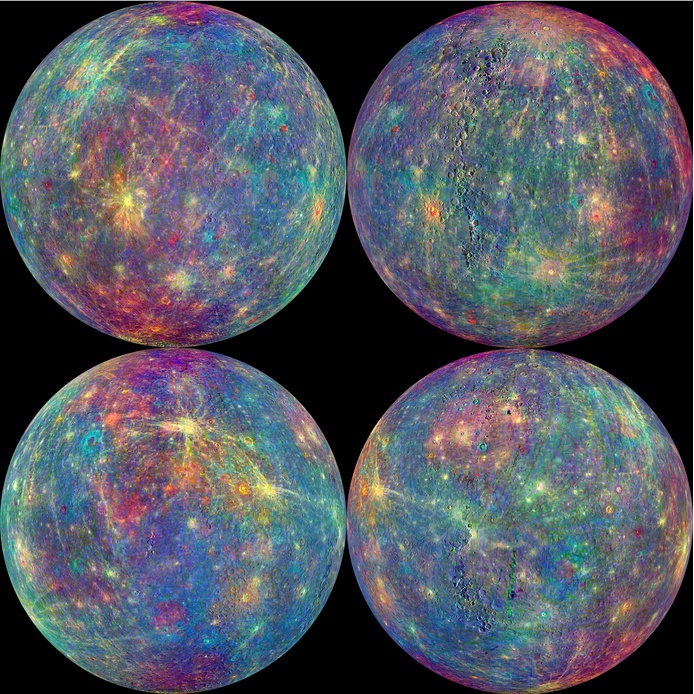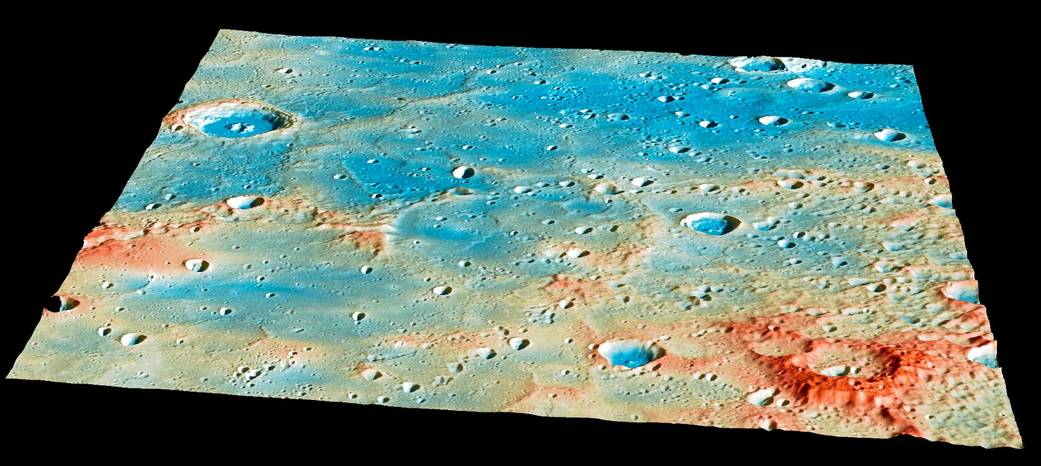MESSENGER mission ends with planned impact on Mercury’s surface

NASA's Mercury exploration mission "MESSENGER" ended on Thursday, April 30, 2015 with a planned impact into Mercury's surface at 19:26 UTC. MErcury Surface, Space ENvironment, GEochemistry, and Ranging (MESSENGER) spacecraft impacted "Shakespeare" basin at a speed of about 14 081 km/h (8 700 mph; ~3.91 km/s).
Mission control confirmed end of operations just a few minutes later, at 19:40 UTC, when no signal was detected by NASA’s Deep Space Network (DSN) station in Goldstone, California, at the time the spacecraft would have emerged from behind the planet. This conclusion was independently confirmed by the DSN’s Radio Science team, which also was monitoring for a signal from MESSENGER.
“Going out with a bang as it impacts the surface of Mercury, we are celebrating MESSENGER as more than a successful mission,” said John Grunsfeld, associate administrator for NASA’s Science Mission Directorate in Washington. “The MESSENGER mission will continue to provide scientists with a bonanza of new results as we begin the next phase of this mission – analyzing the exciting data already in the archives, and unravelling the mysteries of Mercury.”
Prior to impact, MESSENGER’s mission design team predicted the spacecraft would pass a few miles over a lava-filled basin on the planet before striking the surface and creating a crater estimated to be as wide as 15.2 meters (50 feet).

The Mercury Atmosphere and Surface Composition Spectrometer (MASCS) instrument aboard NASA's MESSENGER spacecraft was designed to study both the exosphere and surface of the planet Mercury. To learn more about the minerals and surface processes on Mercury, the Visual and Infrared Spectrometer (VIRS) portion of MASCS has been diligently collecting single tracks of spectral surface measurements since MESSENGER entered Mercury orbit on March 17, 2011. The track coverage is now extensive enough that the spectral properties of both broad terrains and small, distinct features such as pyroclastic vents and fresh craters can be studied. To accentuate the geological context of the spectral measurements, the MASCS data have been overlain on the monochrome mosiac from the Mercury Dual Imaging System (MDIS), an instrument with wide- and narrow-angle cameras to map the rugged landforms and spectral variations on Mercury’s surface.
Image credit: NASA/Johns Hopkins University Applied Physics Laboratory/Carnegie Institution of Washington.
Mercury’s lonely demise on the small, scorched planet closest to the Sun went unobserved because the probe hit the side of the planet facing away from Earth, so ground-based telescopes were not able to capture the moment of impact. Space-based telescopes also were unable to view the impact, as Mercury’s proximity to the Sun would damage optics.
The mood in the Mission Operations Center at APL was both somber and celebratory as team members watched MESSENGER’s telemetry drop out for the last time, after more than four years and 4,105 orbits around Mercury.
“We monitored MESSENGER’s beacon signal for about 20 additional minutes,” said mission operations manager Andy Calloway of APL. “It was strange to think during that time MESSENGER had already impacted, but we could not confirm it immediately due to the vast distance across space between Mercury and Earth.”
MESSENGER was launched on August 3, 2004, and began orbiting Mercury on March 17, 2011. Although it completed its primary science objectives by March 2012, the spacecraft’s mission was extended two times, allowing it to capture images and information about the planet in unprecedented detail.
During a final extension of the mission in March, referred to as XM2, the team began a hover campaign that allowed the spacecraft to operate within a narrow band of altitudes from five to 35 kilometers from the planet’s surface.
On Tuesday, the team successfully executed the last of seven daring orbit correction maneuvers that kept MESSENGER aloft long enough for the spacecraft’s instruments to collect critical information on Mercury’s crustal magnetic anomalies and ice-filled polar craters, among other features. After running out of fuel, and with no way to increase its altitude, MESSENGER was finally unable to resist the Sun’s gravitational pull on its orbit.

The large, 400-kilometer-diameter (250-mile-diameter), impact basin "Shakespeare" occupies the bottom left quarter of this image, acquired by the Mercury Dual Imaging System (MDIS) and Mercury Laser Altimeter (MLA) instruments aboard the MESSENGER spacecraft. The image is coded by topography. The tallest regions are colored red and are roughly 3 kilometers (1.9 miles) higher than low-lying areas such as the floors of impact craters, colored blue. The large crater on the left side of the image is "Janacek," with a diameter of 48 kilometers (30 miles). The Shakespeare impact basin is filled with smooth plains material, likely due to extensive lava flooding in the past. As of 24 hours before the impact, the current best estimates predict that the spacecraft will strike a ridge slightly to the northeast of Shakespeare. View this image to see more details of the predicted impact site and time.
Image credit: NASA/Johns Hopkins University Applied Physics Laboratory/Carnegie Institution of Washington.
“Today we bid a fond farewell to one of the most resilient and accomplished spacecraft to ever explore our neighboring planets,” said Sean Solomon, MESSENGER’s principal investigator and director of Columbia University’s Lamont-Doherty Earth Observatory in Palisades, New York. “A resourceful and committed team of engineers, mission operators, scientists, and managers can be extremely proud that the MESSENGER mission has surpassed all expectations and delivered a stunningly long list of discoveries that have changed our views – not only of one of Earth’s sibling planets, but of the entire inner solar system.”

As the first spacecraft ever to orbit Mercury, MESSENGER revolutionized our understanding of the solar system's innermost planet, as well as accomplished technological firsts that made the mission possible.
Among its many accomplishments, this mission determined Mercury’s surface composition, revealed its geological history, discovered its internal magnetic field is offset from the planet’s center, and verified its polar deposits are dominantly water ice.
Source: NASA
Featured image: NASA

Commenting rules and guidelines
We value the thoughts and opinions of our readers and welcome healthy discussions on our website. In order to maintain a respectful and positive community, we ask that all commenters follow these rules:
We reserve the right to remove any comments that violate these rules. By commenting on our website, you agree to abide by these guidelines. Thank you for helping to create a positive and welcoming environment for all.